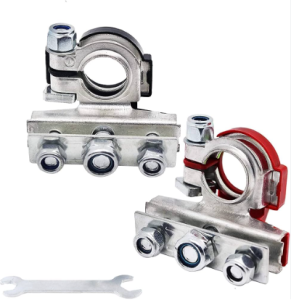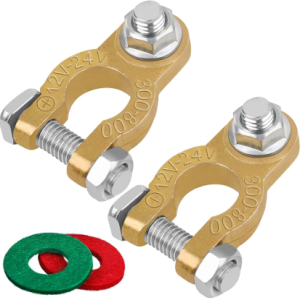Battery Terminal Connectors
In a world driven by technology and innovation, the importance of power cannot be overstated. From smartphones to automobiles, power is the lifeblood that keeps our devices and machines running. At the heart of this power distribution lies a humble yet critical component: battery terminal connectors. These unassuming connectors play a pivotal role in ensuring the efficient flow of power between batteries and the devices they power. In this exploration, we delve into the world of battery terminal connectors, uncovering the best options available that ensure reliability, safety, and performance.
The Vital Role of Battery Terminal Connectors
Battery terminal connectors serve as the bridge between a battery and the electrical system it powers. Whether it’s an automotive battery, an industrial power source, or a household backup system, the efficiency of power transfer greatly depends on the quality of the connectors in use. A well-designed and well-constructed connector ensures minimal resistance, reducing the loss of energy during transmission. This translates to better performance, longer battery life, and reduced energy wastage.
Key Factors in Choosing Battery Terminal Connectors
Selecting the best battery terminal connectors involves considering several key factors, each of which contributes to the overall reliability and performance of the power connection.
Material Quality: The choice of materials significantly impacts the connector’s durability and conductivity. High-quality materials like copper, brass, and stainless steel are commonly used due to their excellent conductivity and resistance to corrosion. These materials ensure a strong connection that can withstand the test of time and environmental conditions.

Connection Type: Battery terminal connectors come in various types, including top post, side post, and universal connectors. The choice depends on the battery type and the application. Top post connectors are standard in most automotive batteries, while side post connectors are often found in specific vehicle models. Universal connectors offer versatility for various battery types.
Design and Construction: A well-engineered connector design ensures a secure and tight connection between the battery terminal and the cable. Features such as serrated edges, locking mechanisms, and compression fittings contribute to a reliable and vibration-resistant connection.
Compatibility: Ensuring that the connector is compatible with the battery type and size is crucial for a successful installation. Mismatched connectors can lead to poor connections, increased resistance, and potential safety hazards.
Safety Features: Safety is paramount when dealing with electrical systems. Some connectors come with features like insulating covers or caps that prevent accidental short circuits and exposure to live terminals.
Ease of Installation: Connectors that are easy to install save time and effort, especially in situations where quick replacements are necessary. Connectors with clear markings and user-friendly designs simplify the installation process.
Unveiling the Best Battery Terminal Connectors
Several battery terminal connectors have gained a reputation for their exceptional quality and performance. These connectors stand out in terms of design, materials, and user experiences:
WirthCo 20092 Battery Doctor Battery Bolt Terminal: This versatile connector features a universal design, making it compatible with both top post and side post batteries. Its brass construction offers excellent conductivity, while the included wing nuts ensure a secure connection.

Erayco Brass Battery Terminals Connectors: These connectors are known for their robust construction and corrosion resistance. The dual-layer design enhances conductivity, and the included insulating covers provide an added layer of safety.
ACDelco 3BA35 Professional Battery Cable Terminal: A trusted name in automotive components, ACDelco offers a battery terminal connector that excels in both performance and durability. Its lead-free construction and corrosion-resistant materials contribute to its reliability.
InstallGear Positive and Negative Battery Terminal: This connector set comes with both positive and negative terminals, ensuring a complete replacement solution. The heavy-duty design, along with the included shims, guarantees a snug fit and minimal resistance.
Schumacher BAF-MT1 Marine Terminal End: Catering to marine applications, this connector is designed to withstand harsh conditions, including saltwater exposure. Its lead-free construction and threaded design make it a reliable choice for marine enthusiasts.
The Intersection of Quality and Performance
In the world of battery terminal connectors, the quest for the best involves striking a delicate balance between quality and performance. From the materials used to the design intricacies, each component plays a role in the connector’s ability to ensure efficient power transmission. Whether it’s for automotive, industrial, or marine applications, the connectors mentioned above represent some of the best options available, each with its unique features tailored to specific needs.
As technology continues to advance, the demand for reliable power connections grows. Battery terminal connectors, often overlooked in their significance, remain a critical link in this chain. Investing in high-quality connectors not only ensures optimal performance but also contributes to the safety and longevity of the devices and systems they power.
Choosing the Best Battery Terminal Connectors: A Comprehensive Guide
Battery terminal connectors might appear as unassuming components, but their significance in maintaining reliable power transmission cannot be understated. Whether you’re dealing with automotive batteries, marine applications, or industrial setups, selecting the right battery terminal connectors is crucial for ensuring optimal performance, safety, and longevity. This guide takes you through the key factors to consider when choosing the best battery terminal connectors for your specific needs.
Material Quality: Conductivity and Durability
One of the foremost factors to evaluate when selecting battery terminal connectors is the quality of materials used in their construction. High-quality materials not only enhance conductivity but also contribute to the connectors’ resistance to corrosion and wear. Copper, brass, and stainless steel are commonly used materials due to their excellent conductivity and durability. These materials facilitate efficient power transfer while withstanding the test of time and various environmental conditions.
Connection Type: Compatibility Matters
Different types of battery terminal connectors are available to suit various applications. The connector type you choose should be compatible with your battery and electrical system. Common types include top post, side post, and universal connectors. Top post connectors are prevalent in most automotive batteries, while side post connectors are often found in specific vehicle models. Universal connectors provide versatility for diverse battery types, making it essential to choose the right type for your specific application.
Design and Construction: Secure and Vibration-Resistant
The design and construction of battery terminal connectors play a pivotal role in establishing a secure and reliable connection. Look for connectors with features that enhance their performance, such as serrated edges, locking mechanisms, and compression fittings. These design elements contribute to a snug fit that minimizes resistance and prevents loosening due to vibrations. A well-engineered connector design ensures that the connection remains intact, even in demanding conditions.
Safety Features: Protection and Peace of Mind
Safety is paramount when dealing with electrical systems. Select connectors that come with built-in safety features. Insulating covers, caps, or shields can help prevent accidental short circuits, protect against exposure to live terminals, and reduce the risk of electrical accidents. Prioritizing safety features not only safeguards the components but also enhances the overall reliability of the electrical system.
Ease of Installation: User-Friendly Solutions
When time is of the essence, ease of installation becomes a critical consideration. Opt for connectors that are user-friendly and straightforward to install. Connectors with clear markings, color coding, and intuitive designs simplify the installation process, reducing the chances of errors during setup. Quick and hassle-free installation can be particularly advantageous in scenarios where replacements are required urgently.
Reviews and Reputation: Learning from Others
Before making a final decision, it’s wise to gather insights from user reviews and assess the reputation of the brand or manufacturer. Reading reviews from individuals who have used the connectors in similar applications can provide valuable information about their real-world performance, durability, and ease of use. Additionally, opting for reputable brands known for producing high-quality electrical components can enhance your chances of selecting reliable battery terminal connectors.
In conclusion
the world of battery terminal connectors is a testament to the intricate interplay of design, materials, and engineering. The best connectors are those that seamlessly facilitate the flow of power while ensuring safety, durability, and efficiency. As consumers and industries alike rely on uninterrupted power for their diverse needs, these connectors stand as guardians of a vital connection that keeps the modern world moving forward.
Frequently Asked Questions (FAQs) about the Best Battery Terminal Connectors
What are battery terminal connectors, and why are they important?
Battery terminal connectors are components that establish a secure and efficient electrical connection between batteries and the devices they power. They play a vital role in ensuring the smooth flow of power, reducing energy loss, and preventing potential hazards such as short circuits. Quality connectors are essential for optimal performance, safety, and the longevity of battery-operated systems.
How do I choose the right battery terminal connector for my application?
Choosing the best battery terminal connector involves considering factors like material quality, compatibility, design, safety features, ease of installation, and user reviews. Select connectors made from high-quality materials like copper or brass for better conductivity and durability. Match the connector type to your battery’s specifications, whether it’s a top post, side post, or universal connector. Prioritize connectors with secure design elements and safety features, and ensure they are easy to install. Reading user reviews can provide insights into real-world performance.
What materials are commonly used in battery terminal connectors?
High-quality battery terminal connectors are typically constructed from materials like copper, brass, and stainless steel. These materials are chosen for their excellent conductivity, resistance to corrosion, and overall durability. Copper is known for its exceptional conductivity, while brass and stainless steel offer a balance between conductivity and corrosion resistance.
Can I use universal connectors for all types of batteries?
Universal connectors are designed to be versatile and compatible with various battery types. However, it’s essential to ensure that the universal connector you choose is suitable for your specific battery’s requirements. While they provide flexibility, always double-check compatibility to avoid poor connections or safety risks.
Are safety features important in battery terminal connectors?
Yes, safety features are crucial in battery terminal connectors, as they help prevent accidents, short circuits, and electrical hazards. Connectors equipped with insulating covers, caps, or shields provide an extra layer of protection, reducing the risk of accidental contact with live terminals and enhancing overall safety. When selecting connectors, consider those with built-in safety features to ensure a secure and reliable electrical connection.
